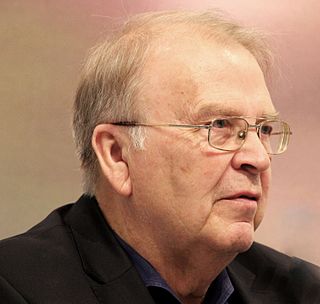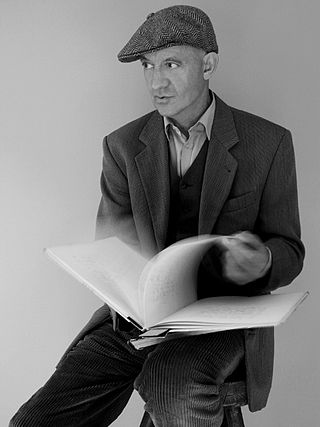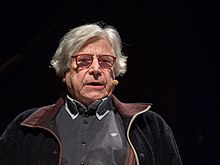
Peter Weibel is an internationally known Austrian post-conceptual artist, curator and new media theoretician. He started out in 1964 as a visual poet but soon jumped from the page to the screen within the sense of post-structuralist methodology. Thanks to this linguistic input into his visual media works, Weibel developed a critical impulse that turned against society and the media, while investigating virtual reality and other digital art forms. Since 1999 he has been director of the ZKM Center for Art and Media Karlsruhe.

Wilhelm Genazino was a German journalist and author. He worked first as a journalist for the satirical magazine pardon and for Lesezeichen. From the early 1970s, he was a freelance writer who became known by a trilogy of novels, Abschaffel-Trilogie, completed in 1979. It was followed by more novels and two plays. Among his many awards is the prestigious Georg Büchner Prize.

The Schirn Kunsthalle is a Kunsthalle in Frankfurt, Germany, located in the old city between the Römer and the Frankfurt Cathedral. The Schirn exhibits both modern and contemporary art. It is the main venue for temporary art exhibitions in Frankfurt. Exhibitions included retrospectives of Wassily Kandinsky, Marc Chagall, Alberto Giacometti, Bill Viola, and Yves Klein. The Kunsthalle opened in 1986 and is financially supported by the city and the state. Historically, the German term "Schirn" denotes an open-air stall for the sale of goods, and such stalls were located here until the 19th century. The area was destroyed in 1944 during the Second World War and was not redeveloped until the building of the Kunsthalle. As an exhibition venue, the Schirn enjoys national and international renown, which it has attained through independent productions, publications, and exhibition collaborations with museums such as the Centre Pompidou, the Tate Gallery, the Solomon R. Guggenheim Museum, the Hermitage Museum, or the Museum of Modern Art.

Arnold Stadler is a German writer, essayist and translator.

Max Bense was a German philosopher, writer, and publicist, known for his work in philosophy of science, logic, aesthetics, and semiotics. His thoughts combine natural sciences, art, and philosophy under a collective perspective and follow a definition of reality, which – under the term existential rationalism – is able to remove the separation between humanities and natural sciences.
Der Dativ ist dem Genitiv sein Tod is a series of books by Bastian Sick which deal in an entertaining manner with unappealing or clumsy use of the German language, as well as areas of contention in grammar, orthography, and punctuation.
Karl Albert was a German philosopher and professor emeritus at Bergische Universität Wuppertal.
Anna Blume and Bernhard Johannes Blume were German art photographers. They created sequences of large black-and-white photos of staged scenes in which they appeared themselves, with objects taking on a "life" of their own. Their works have been shown internationally in exhibitions and museums, including New York's MoMA. They are regarded as "among the pioneers of staged photography".
Rüdiger Schmidt-Grépály is a German cultural manager and Director of the Kolleg Friedrich Nietzsche at the Klassik Stiftung Weimar.

Robert Wolfgang Schnell was a German writer.

Gerhard Zwerenz was a German writer and politician. From 1994 until 1998 he was a member of the Bundestag for the Party of Democratic Socialism (PDS).

Natias Neutert is a German artist, author, poet, orator, and translator who lives in Hamburg and Berlin.
Klaus Berger was a German art historian and professor at the University of Kansas. He wrote books on Gericault, Odilon Redon and Japonisme.
Norbert Miller is a German scholar of literature and art. He was professor of literary studies at the Technische Universität Berlin from 1973 and retired in 2006.
Gabriele Henkel, was a German art collector, art patron, author and artist. She was married to Konrad Henkel, the long-standing head of the Henkel Group.
Friedrich Gustav Schilling was a German musicologist, editor and lexicographer.
Peter Sühring is a German musicologist, publicist and music critic.

Konrad Paul Liessmann is an Austrian philosopher, essayist and cultural publicist. He is a university professor for "Methods of Teaching Philosophy and Ethics" at the University of Vienna. He officially retired in 2018, but continued his professorial activities at the University of Vienna on a special contract basis until the end of 2020.
Guido Jendritzko was a German sculptor, painter, graphic artist and photographer. He was an important and versatile representative of Abstract art after the Second World War.
Stefan Koldehoff is a German journalist, art market expert and non-fiction author. He became known through numerous publications and his work as culture editor of the Deutschlandfunk.










